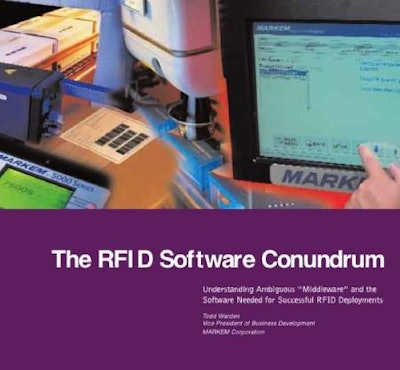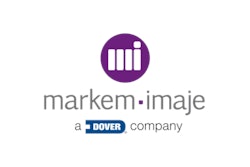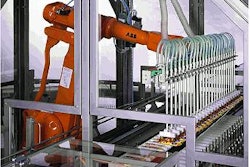
Markem’s whitepaper, The RFID Software Conundrum, is intended to clarify a confusing landscape and marketplace for RFID software. This never-before published paper is subtitled Understanding Ambiguous ‘Middleware’ and then Software Needed for Successful RFID Deployments.
Unfortunately, few industry analysts have been able to portray an accurate picture of what is and will be required as RFID goes mainstream and is integrated into all aspects of a manufacturer’s infrastructure and processes. Some vendors have only served to complicate the problem, because so many view this market opportunity as their driver of their future growth.
In the end, the suppliers to Wal-Mart are suffering because they do not know what they need or where to get it. In the current marketplace, there is no silver bullet solution and certainly no single solution that will cover the full range of functionality required from a single vendor. Unfortunately, this is just another area where the suppliers are going to have to struggle and figure it out on their own. Hopefully this document will help provide some clarity on what will be needed over time.
This whitepaper provides a functional view of what software is necessary for a successful RFID deployment, and shed a much clearer view of what is captured in the broad term defining “RFID Middleware.”
The paper offers four major sections: Defining the challenge; Turning the Tide, Putting it all Together, and a Call to Action.
Middleware?
Middleware has been used as a catch-all bucket to describe software that unlocks a huge new value. The reality is that very complex systems are in place, and will require careful scrutiny to understand how the EPC/RFID paradigm will peacefully coexist and ultimately enhance the overall value delivered by the infrastructure. Those systems include, but are not limited to MES (Manufacturing Execution Systems), ERP (Enterprise Resource Planning), WMS (Warehouse Management Systems) and SCM (Supply Chain Management) systems.
Turning the Tide
The significance of manufacturers considering applying RFID tags to cases on the production line or at the source (“source tagging”) should not be underestimated. Most believe this is the ultimate end state of how and where the industry will deploy the technology to reduce costs while also increasing data integrity. As this occurs, the need and reliance for suppliers to synchronize data with both their ERP and MES systems increases dramatically. For those thinking about deploying solutions today solely focused on the warehouse or distribution end of their supply chain, they can virtually ignore what is happening behind them in the chain and focus on WMS (and perhaps SCM) integration. And while this simplifies their immediate challenge, it is only postponing the inevitable, and also provides very little means to actually extract an ROI.
From Distribution to Manufacturing
When taking a “slap and ship” approach, whether manual or automated, the data management and data integration needs are relatively well defined. Especially if the scope of the tagging operation is limited to a facility or two with a limited number of stockkeeping units and a single point of integration into a WMS system. The challenge escalates exponentially however as deployment scales to a larger number of products and facilities, includes integration in broader SCM systems, and requires greater data and device management across the supply chain. It becomes further complicated once integration to an overall ERP system is required as well as the autonomous function of the production line, not to mention the need to fit within an overall IT and network infrastructure that provides security and complies with company and industry standards.
The whitepaper concludes with a Call to Action.
Call to Action
The “Wild West” feel of the RFID market continues and has shifted its focus to software as the hardware physics are getting figured out, and as we get closer to real deployments. Here are suggestions on getting your hands around software functionality and requirements:
This whitepaper was authored by Todd Warden, vice president of business development. For further information, visit the Markem Web site, below. To read the complete 8-page PDF format document, click here and it will download directly to your desktop.
























